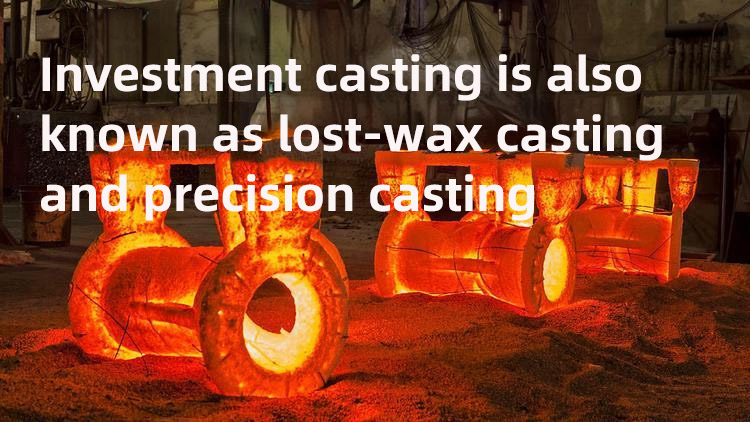Investment Casting (Lost-Wax Process): Precision Manufacturing for Aerospace Turbine Blades, Medical Implants & High-Temperature Alloys
2025-04-02 15:02:32 hits:0
When aerospace engineers need to produce turbine blades with a thickness of just 0.1mm and surface precision up to ±0.05mm, the 5,000-year-old investment casting (lost-wax process) becomes the critical technology. This technique, which underpins 90% of modern aerospace engine components, continues to push precision boundaries in medical devices, luxury goods manufacturing, and other high-value industries.
As a professional foundry enterprise, Tiegu will next provide you with a detailed introduction to investment casting (also known as lost-wax casting), a precision manufacturing process that is widely applied in industries such as aerospace, automotive, and medical devices.

How investment casting works?
The investment casting (lost-wax process) achieves precision metal forming through a soluble pattern replication technique. The core workflow involves: creating wax patterns by injecting low-temperature paraffin into molds, assembling patterns into tree-like structures, and applying ceramic slurry layers to form a robust shell. Steam dewaxing and high-temperature sintering remove the wax and densify the shell, followed by vacuum casting of molten alloys. After cooling, the shell is removed to yield high-precision castings requiring no post-machining.
What is investment casting process?
How Investment Casting Differs From Other Types of Casting
Investment casting excels in precision, material compatibility, and structural complexity:
Comparison Data:
Why is it Called Investment Casting and Other Names?
The term "investment casting" originates from the Latin word "investire," meaning "to clothe" or "to cover." This refers to the process of encasing the wax pattern with ceramic investment material, which forms the protective shell during casting. While "investment casting" is the standardized term in engineering contexts, the process is also widely known as lost-wax casting due to its core step of melting away the wax pattern before metal pouring.
Alternative Names in Practice(other name)
Depending on regional or industrial contexts, you may encounter these synonyms:
Precision Casting – Highlights its capability to achieve CT4 dimensional accuracy
Expendable Pattern Casting – Focuses on the sacrificial nature of the wax model
Ceramic Mold Casting)– Describes the refractory shell material
Investment Casting Process Explained
A Step-by-Step Guide for Precision Metal Parts
1. Wax Pattern Creation
The process begins with designing 3D models using CAD software, where 0.3-0.6% shrinkage compensation is factored in to account for metal solidification. Low-temperature paraffin wax (48-52℃ melting point) mixed with 15% stearic acid is then injected into precision-machined aluminum molds at 5-8MPa. This results in wax patterns with wall thickness ranging from 0.5-3mm and dimensional accuracy of ±0.05mm.
Technical Edge: Aluminum molds with Ra≤0.8μm surface finish ensure smooth pattern release.
2. Cluster Assembly
Individual wax patterns are welded to runners using heated air guns, forming tree-like clusters. These assemblies undergo X-ray inspection to detect internal bubbles smaller than 0.2mm in diameter, ensuring structural integrity before casting.
Quality Control: Cluster weight variation is maintained within ≤5g to balance metal flow during pouring.
3. Ceramic Shell Formation
The clusters are repeatedly dipped in silica sol-zircon slurry (30-35% SiO₂ content) and coated with refractory sands. After 7-9 layers and 4-6 hours of drying between coats, the shells are sintered at 980℃. This process creates ceramic shells with ≥30MPa bending strength capable of withstanding 1500℃ molten metal.
Material Science: Zircon flour provides high thermal stability, while mullite sand enhances structural rigidity.
4. Dewaxing & Cleaning
Steam at 160℃ removes the wax patterns, leaving less than 0.05% residue. High-pressure air blasting then clears any remaining debris from the shell cavities. Approximately 95% of the wax is recycled for reuse.
Environmental Advantage: Advanced wax recovery systems minimize material waste.
5. Vacuum Casting
Nickel-based superalloys like Inconel 718 are melted at 1550±20℃ in vacuum induction furnaces. The molten metal is poured into the ceramic shells under ≤10Pa vacuum to eliminate porosity, ensuring dense, defect-free castings.
Process Innovation: Vacuum environment reduces oxidation and improves material purity.
6. Cooling & Demolding
Casted parts are cooled gradually—first in the furnace to 600℃, then air-cooled at 5-10℃ per minute. Vibration shaking removes over 99.9% of the ceramic shell, leaving near-net-shape metal components.
Stress Control: Slow cooling prevents thermal distortion in complex geometries.
7. Final Processing & Inspection
Surface finishing via aluminum oxide blasting achieves Ra1.6-6.3μm roughness. Coordinate measuring machines verify CT4 dimensional tolerance (±0.15mm/25mm), while CT scans with 5μm resolution detect internal defects.
Certifications: Processes comply with ISO 9001, AS9100D (aerospace), and ISO 13485 (medical) requirements.
What is investment casting products advantages and disadvantages?
Advantages of Investment Casting
Technical Data
Limitations of Investment Casting
Risk Mitigation Strategies
Decision Matrix
| Criteria | Investment Casting | Alternative Processes |
|---|---|---|
| Complexity | Excellent | Limited |
| Precision | CT4 | CT6-CT8 |
| Material Cost | High | Low-Medium |
| Lead Time | Long | Short |
| Environmental Impact | Moderate (improving) | Varies |
What is the application of investment casting?
What Are the Examples of Investment Casting Products?Investment casting is used to produce high-precision components across critical industries, including:
Why These Products Use Investment Casting
✅ Complex geometries (e.g., internal cooling channels in turbine blades)
✅ High-temperature materials (e.g., nickel-based superalloys melting at 1330℃)
✅ Surface finishes meeting medical/consumer standards (Ra1.6-6.3μm)
Why Is Investment Casting Expensive?
Investment casting incurs higher costs due to its precision-driven process and material requirements, including:
Cost Mitigation Strategies
Tiegu's Approach
Leverages automated ceramic coating robots and in-house alloy melting capabilities to lower costs by 25% compared to industry averages.
What Materials Are Utilized in Investment Casting?
Investment casting is a versatile process that can work with a wide range of materials to meet different industrial needs. Here are the main materials employed:

 en
en  fra
fra  de
de  ru
ru  ara
ara  gle
gle  it
it  jp
jp  kor
kor  th
th  zh
zh 


